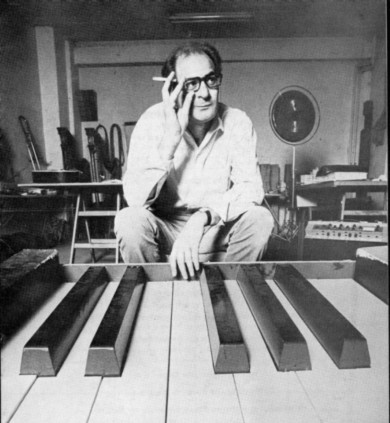Miami percussionist trio brings Kagel’s “Dressur” to wacky life
During the 1960’s and 70’s, the Darmstadt International Summer Course for New Music became the creative and educational center of Europe’s musical avant garde. The program encompassed such iconic artists as Pierre Boulez, Karlheinz Stockhausen, György Ligeti, Luciano Berio and Luigi Nono.
German-Argentine composer Mauricio Kagel emerged as the clown prince of the Darmstadt group, creating works that he dubbed “musical circuses.” Also an experimental filmmaker, Kagel was a multitalented innovator, much like the American iconoclast John Cage (whose work encompassed film and photography as well as composition).
On Saturday afternoon, Dressur, one of Kagel’s most famous circus works, was presented in the project space at the Center for Visual Communication in Wynwood. Scored for three percussionists playing marimba and wooden instruments–many quite exotic–Kagel’s thirty- minute work explicitly requires the performers to act, dance and move around the stage during the performance without facial expressions or emotional gestures. Indeed Kagel insisted that the dramatic presentation had no specific meaning. Falling between performance art, Theater of the Absurd and a Hal Roach comedy short, Dressur is as much a theatrical piece as a concert work.
While much of the music that emerged from the Darmstadt School was sterile or merely intellectual experimentation, Kagel’s work is unabashed fun. You have to love a piece that features such instruments as Central American water drums, Korean clappers, wooden shoes, a scraper stick and bouncing ball box as well as the more familiar marimba, castanets and maracas. Kagel deploys this battery and its players with considerable humor and slapstick interplay.
At times the three players perform rhythmic patterns in unison; at others their individual rhythms run counter or in opposition to each other. Karlyn Viña opened with a jaunty tune on the marimba but was interrupted by Tyson Voigt threatening to attack her with a chair. Holding her mallets in her mouth, she returned to the initial motif, playing the instruments with her fingers. From there the wildly imaginative antics took off. Michael Weinfield-Zell, the coordinator of the project, played body percussion while Voigt’s scraper stick backed up the marimba pattern.
Viña hummed a wordless melody while playing colorful African chimes, later repeating it on her mallet instrument. The water bowl drums almost sounded like timpani and Weinfield-Zell’s wooden shoes were utilized both as a struck percussive instrument and as cloggers beating time along the floor. In a final coup de theatre, Viña played a dazzling marimba solo at nearly impossibly fast speed, threw down her mallets and stomped off stage while the other two players collapsed.
Kagel’s 1977 percussive tour de force still retains its mirth and penchant to surprise an audience. All three players assayed this difficult and complex musico-theatrical essay from memory. Their performance was both breathtaking and splendidly realized.
Viña deserves particular praise for her mastery of the busy marimba part, not to mention her incisive dancing, whistling and vocalizing. Voigt handled a myriad number of sticks, chairs, ball box and even the marimba (as a duo with Viña) with skill and aplomb. The overflow audience awarded the musicians prolonged applause.
Prior to the performance of Dressur, excerpts from several of Kagel’s films were shown. Most notable was his 1969 Ludwig van… in which Beethoven reawakens, shaves and takes the train to modern day Bonn (his birthplace) where he sees his own pipes and belongings at the Beethoven Haus museum and visits a record shop, finding shelves of long playing vinyl recordings of his work.
A video of an excerpt from Kagel’s Konzertstuck for Timpani concluded with the player going head first through the skin of one of the instruments, typical of the composer’s zaniness.
Posted in Performances
Leave a Comment
Sun Feb 7, 2016
at 1:14 pm
No Comments






